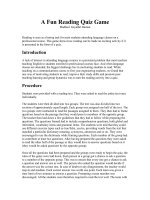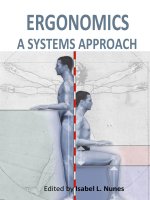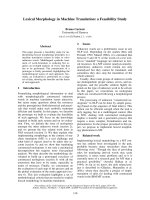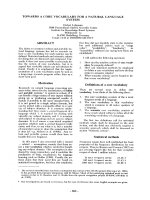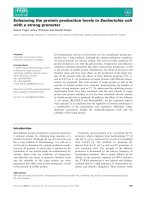“Crouching Tiger, Hidden Dragon : A Transnational Reading” potx
Bạn đang xem bản rút gọn của tài liệu. Xem và tải ngay bản đầy đủ của tài liệu tại đây (316.92 KB, 57 trang )
S
“Crouching Tiger, Hidden Dragon
eptember, 2002
:
Introduction
A Transnational Reading”
1
Ang Lee’s martial arts melodrama Crouching Tiger, Hidden Dragon (henceforth
CTHD) was a worldwide cinematic phenomenon in 2000-2001. Made with a relatively
modest budget of $15 million it earned over $200 million worldwide, outperforming all
other Chinese-language films in Asia as an aggregate territory and propelling the jaded
critics at the Cannes film festival into a standing ovation. It achieved extraordinary
success in the United States: in a market notoriously hostile to subtitled fare it earned
$128 million in the theaters, plus another $113 million in video and DVD rentals and
sales. CTHD
made the rare transition out of the art-houses and into the multiplexes, and
in doing so it became the most commercially successful foreign-language film in US
history and the first Chinese-language film to find a mass American audience. Critically
acclaimed as well as popular, it broke records at the Academy Awards, where it was the
first foreign-language film to be nominated for ten awards and the first Asian language
film to be nominated for best picture. The press heralded it as a breakthrough film that
1
might succeed in prying open the lucrative American market to the products of Asian
film industries.
2
Part of the film’s significance, apart from its critical and financial success, derives
from th
etrieve
ll of
e way it displays the simultaneously localizing and globalizing tendencies of mass
culture in our contemporary moment. In its visual and narrative content, the film comes
across as resolutely Chinese local. Based on a pre-World War II Chinese novel by Wang
Du Lu that has never been translated into English and set in the jiang hu underworld of
bandits and heroes during the Qing dynasty (1644 –1911), it tells the story of two
renowned martial artists (played by Chow Yun-fat and Michelle Yeoh) who must r
a sword stolen by a rebellious young aristocratic woman (played by Zhang Zhiyi).
Thematically, the film revolves around the tension between the characters’ Taoist
aspiration to follow the “way” and their Confucian sense of obligation to others. A
the actors, like director Ang Lee, are ethnic Chinese and several of them are major stars
in East Asia. The film offers stunning vistas of mainland China – location shooting was
done in the Gobi Desert, the Taklamakan Plateau north of Tibet, the Uigur-speaking city
of Urumqi in the far west, the bamboo forests of Anji in the south, and the imperial city
of Chengde in the North – and it brings ancient China vividly to life through sumptuously
detailed period costumes and decor. The film matches this visual texture aurally by using
2
Mandarin for all the dialogue. This conspicuous Chineseness at the narrative, thematic,
visual, and aural levels locates the film within a cinematic renaissance – exemplified by
the work of directors such as Chen Kaige and Zhang Yimou in China, John Woo and
Wong Kar-wai in Hong Kong, Tsai Ming-liang and Hou Hsiao-hsien in Taiwan – that
since the mid-1980s has called the world’s attention to the diverse local film industries
greater China.
3
CTHD
of
’s production, in contrast, was astoundingly global. The prominent
contrib ness
ics
ms for
ng
utions of American James Schamus, Ang Lee’s long-time creative and busi
partner, immediately complicate any simple notion of the film’s Chineseness. As
executive producer, Schamus put together a complex financing scheme in part by
advance selling the international distribution rights. Much of the money came from
various divisions of Sony, the Tokyo-based media conglomerate: Sony Pictures Class
in New York bought the US distribution rights; Columbia Pictures in Hollywood picked
up rights for Latin America and several Asian territories; Columbia Pictures Film
Production Asia, a Hong Kong-based entity designed to produce local-language fil
the Asian market, provided funds; and Sony Classical music financed the soundtrack.
Schamus’ own Good Machine International contributed its portion of financing by selli
rights to a bevy of European distributors, including Bim in Italy, Warner Bros. in
3
France, Kinowelt in Germany, Lauren Films in Spain, and Metronome in Scandinav
The actual cash for the film came from a bank in Paris, while a completion bond
company in Los Angeles insured the production. In addition to executive producin
film (and writing the lyrics for its Academy Award-nominated theme song), the New
York-based Schamus also co-wrote the screenplay, working with Taiwan-based writer
Wang Hui Ling in a process that entailed translating drafts back and forth between
English and Chinese. The actual production of the film involved five different comp
in five countries. Ang Lee, who lives in New York, produced the film through United
China Vision, a Taiwanese company he created that included his fellow producers Bill
Kong of Edko Films in Hong Kong and Hsu Li Kong of Zoom Hunt Productions in
Taiwan; Lee’s company also created a subsidiary in the British Virgin Islands and a
limited-liability corporation in New York. Two mainland companies were also broug
in: the privately-owned Asia Union Film and Entertainment and the state-run China Film
Co-Production Corporation (Chinese regulations require all foreign films shot and
distributed in China to partner-up with a state-owned company). Once the location a
Beijing studio shooting was finished, the soundtrack was recorded in Shanghai, post-
production looping took place in Hong Kong, and the film was edited in New York.
4
ia.
g the
anies
ht
nd
4
The simultaneously global and local nature of CTHD
has led many viewers to
grapple with the film’s national-cultural identity. Some tried to wish this complexity
away by identifying the film in singular terms as a Chinese, Hong Kong, Taiwanese, or
even Hollywood film. The more analytical responses unfolded along a continuum whose
poles are marked by two popular models for thinking about cultural globalization. At one
end stands Salman Rushdie who, writing on the op-ed page of the New York Times
,
viewed the film as an act of local resistance against global Hollywood’s domination.
Rushdie celebrated CTHD
as an unambiguously “foreign” “art” film and an exemplar of
a revitalized “world cinema” that could potentially break America’s stranglehold on the
world’s movie screens. Affiliating Ang Lee with Akira Kurosawa, Satyajit Ray,
Frederico Fellini, and Ingmar Bergman – directors who had “pried Hollywood’s fingers
off the cinema’s throat for a few years” – Rushdie praised CTHD
as a descendent of the
self-consciously national European and Asian cinemas that arose after World War II and
that he saw as resisting an earlier stage of US cultural domination. Many of the Western
reviewers who gave the film high marks shared Rushdie’s views. At the other end of the
continuum stands Derek Elley, who reviews Asian films for the Hollywood trade journal
Variety
and who emphasized CTHD’s globalizing tendencies. Reading the film via a
model of cultural imperialism, he dismissed it as "cleverly packaged chop suey …
5
designed primarily to appeal to a general Western clientele." Elley condemned CTHD
as
culturally inauthentic, asserting that its Asianness had been fatally corrupted by its
absorption of Western cinematic conventions, and he damned Ang Lee as a “cultural
chameleon” – an “international filmmaker who just happens to have been born and raised
in Taiwan” – who did not belong in the canon of Asian filmmakers. Far from loosening
up America’s grip on the world’s screens, CTHD
in Elley’s eyes embodied Hollywood’s
colonization of the martial arts genre and its power to render invisible the genuinely
Chinese artistry of earlier directors such as Hong Kong’s King Hu. This charge of
inauthenticity was echoed by genre purists who complained about the actors’ lack of real
martial arts skill, academics who questioned the historical accuracy of the costumes and
setting, and native-Mandarin speakers who winced at some of the actors’ pronunciation
and the “Dan Quayle-like spelling misdemeanours” in the subtitles.
5
Despite the popularity of their views, both Rushdie and Elley offer inadequate
models for understanding this film, and by extension contemporary cinema in general.
Each one assumes that movies can still can be understood in terms of singularity, as more
or less culturally pure artifacts that take shape within individual countries and film
industries. Rushdie assumes that one can still draw a clear line demarcating Hollywood
from “world cinema,” while Elley works furiously to shore up a hard-and-fast distinction
6
between “Asian” and “Western” cinematic styles. Both of them see the local and the
global in oppositional terms, as impulses that can be neatly delineated from one another
and that exist in a relationship of domination and resistance that necessarily implies the
criteria of authenticity. Lee’s film demands, instead, a more transnational critical
perspective, one that enables us to see how the local and the global are inextricably bound
up with one another and that can illuminate what Aihwa Ong has called “the condition of
cultural interconnectedness and mobility across space” that characterizes our current
moment. CTHD
is worth studying precisely because it is embedded within a network of
transnational flows – of people, capital, texts, and ideas – that muddy the distinction
between the global and the local. The film emerged not out of any neatly-bounded
national or cultural space called “China” , “Taiwan,” “Hong Kong,” “Hollywood,” or
even “the East” or “the West”, but from the boundary-crossing processes of war,
migration, capitalist exchange, aesthetic appropriations, and memory.
6
We can best see this film from a global perspective if we think about director Ang
Lee as a member of the Chinese diaspora and consider CTHD
as a work of diasporic
filmmaking. A diaspora is a transnational ethnoscape created when a people disperses,
willingly or unwillingly, from an original homeland and resettles in a diversity of other
locations. Diasporas are fundamentally hybrid entities, shaped by their location in
7
multiple places and their participation in multiple societies. Out of this historical
experience of uprooting and resettlement often emerge works of culture that have a
distinctive diasporic shape. CTHD can be profitably read as such a work: it is materially
grounded in multiple geographic locations, makes multiple aesthetic affiliations, and fails
to map neatly onto a single nation-state or cultural tradition. An awareness of this
multiplicity allows us to step beyond the sterile binaries of domination and resistance,
corruption and authenticity that structure Rushdie’s and Elley’s mechanistically
predictable moral-aesthetic judgments. In reading CTHD
as a diasporic film, I want to
focus on how its material production and its aesthetic form have been shaped by Ang
Lee’s embededness within a triangulated set of transnational relationships: to his Chinese
homeland, to other members of the Chinese diaspora, and to the culture of his American
hostland.
7
The Axis of Origin and Return
Ang Lee has thought carefully about the cultural dynamics of globalization. In
Ride with the Devil
(1999), the film he made immediately prior to CTHD, Lee used the
genre of the American Western to explore globalization’s nineteenth-century origins. Lee
felt drawn to this Civil War story, which focuses on three Southerners whose encounter
8
with the North radically transforms their whole way of life and thinking, because it
captured something about his own experience growing up in Taiwan in the 1950s, "where
older people always complained that kids are becoming Americanized they don't
follow tradition and so we are losing our culture." In Ride with the Devil Lee grappled
with the historical roots of the contemporary changes he saw taking place throughout
Asia and the rest of the world: in making the film, he "realized the American Civil War
was, in a way, where it all started. It was where the Yankees won not only territory but,
in a sense, a victory for a whole way of life and of thinking." The Civil War marked for
Lee the first stage of globalization, the moment when Americans began to export their
values of individualism, democracy, and capitalism.
8
It is tempting to read CTHD as a response to the issues raised in Ride with the
Devil, as an authentic expression of a Chinese local which stands in contrast to the
Yankee American global. In interviews, Lee has described CTHD as a "Chinese film"
and cast it in cultural-nationalist terms. Dipping into the language of cultural
essentialism, he describes the film's emotional subtext – the anguish of lovers who cannot
express and act on their feelings for each other – as "the great Chinese theme" of
literature, painting, and other art forms, something that "is just in our blood. " Lee here
presents his film as a deeply-rooted Chinese endeavor, one that not only resonates with
9
other works of Chinese art, but that emanates from the depths of the Chinese soul itself.
Lee asserts this Chineseness most insistently through his choice of genre, the martial arts
film being the most iconic of Chinese film forms. (Lee had used martial arts as a
metaphor for Chineseness in his first feature film, the 1992 immigrant family drama
Pushing Hands
, which tells the story of an elderly tai chi master who must adjust to a new
life in New York.) With CTHD
, Lee immersed himself in the martial arts genre, hewing
closely to its well-established conventions even as he takes them in new directions. The
film pays homage to earlier movies and creatively recycles the familiar narrative tropes
of the master whose death must be avenged, the stolen book of martial arts secrets that
must be recovered, the skillful student who lacks maturity, and the rogue villain who tries
to operate outside the strict conventions of school and lineage.
9
In keeping with the film’s evocation of a mainland Chinese local, Lee has
publicly framed his film within the discourse of home, describing it as a personal
"homecoming of sorts." His qualifying “of sorts,” however, needs to be taken seriously:
China is not Lee’s “home” in any simple way, and CHTD
did not emerge organically out
of a mainland Chinese local. Rather, Lee is working with a fundamentally diasporic
notion of homecoming.
10
10
CTHD
is perhaps best understood as a diasporic act of symbolic return.
Anthropologist James Clifford describes diasporas, and by implication diasporic cultures,
as being oriented along “an axis of origin and return.” The existence of a homeland,
perhaps more than any other factor, shapes diasporic culture. Unlike a conventional
home, a diasporic homeland is defined by its absence rather than its presence; it is an
emotionally resonant home from which one has been separated by time, physical
distance, and the experience of loss. Despite this separation, the members of a diaspora
remain bound to the homeland through material, symbolic, or psychological ties. A
collective memory of the homeland – sometimes invented – suffuses diasporic culture,
and fuels a central diasporic desire: the desire for return. The nature of this return can
take various forms, from the physical to the millenarian to the symbolic. However that
desire manifests itself, it imparts a linear quality to diasporic culture by directing it
towards a singular point of reference that is located physically elsewhere and temporally
in the past.
11
The American press invariably refers to Lee as a “Taiwanese” director, but this
identification masks a complex history and identity. Lee is better understood as a member
of the Chinese diaspora, a world-spanning ethnoscape that does not map easily onto the
political boundaries of any single nation-state or the cultural boundaries of any region or
11
“civilization.” The Chinese diaspora, which originated in the 15
th
century and expanded
alongside European imperialism and the coolie trade, today encompasses thirty million
people living on virtually every continent.
12
Lee's family joined the diaspora relatively
late. His parents fled mainland China during the civil war of the late 1940s, the only
members of their respective families to escape execution by Mao’s forces, and like many
anti-communists they settled in Taiwan. These refugees quickly became permanent
settlers who dominated the local Taiwanese population, imposing their Nationalist
political party and their mainland culture onto a people who, after fifty years of Japanese
colonialism, already possessed a complexly hybrid culture of their own. Lee was born in
1954 and grew up in an exclusive society that simultaneously looked back to its mainland
origins and outward to the culture of its Cold War patron, the United States. After failing
his college entrance exams and studying acting for a few years, Lee left Taiwan for the
United States in 1978, thus participating in a second diasporic remove that sent many
Taiwanese to the US to pursue higher education. He earned a bachelor’s degree in
theater at the University of Illinois and a master's in film production from New York
University. He married a microbiologist who had been a fellow graduate student at
Illinois, had two children, moved to suburban New York, and began making movies. By
12
the time he made CTHD
, Lee had lived in the US for almost as long as he had lived in
Taiwan. He has made all his movies since moving to New York.
13
In some ways Lee seems a typical immigrant who could be considered an ethnic
American filmmaker. He has evaded that category, however, by retaining significant
legal, financial, and cultural ties to Taiwan. He made his first three movies, Pushing
Hands (1992), The Wedding Banquet (1993), and Eat, Drink, Man, Woman (1994)with
financing from Taiwan’s largest film studio; he shot Eat, Drink, Man, Woman in Taiwan;
and all three films feature Taiwanese actors and use Mandarin dialogue either partially or
exclusively. In addition, Lee has retained his Taiwanese citizenship.
14
Lee's status as a member of the diaspora complicates both his own sense of
Chineseness and any simple cultural-national identification of CTHD
as a Chinese movie.
More important, it challenges any simple notions of cultural authenticity. Growing up in
Taiwan, Lee had no direct experience of mainland China, and as an adult he made only
one brief five-day visit there; not until he spent five grueling months filming CTHD
there
did he have his first sustained encounter. He grew up with a powerful sense of connection
to the mainland, but that connection was complicated by the ideological chasm that
separated Taiwan from communist China during the 1950s, 1960s, and 1970s. Like the
rest of his generation, he did not really know China. His sense of connection was always
13
mediated by distance, time, other people, and mass media. "I … found out about the old
China,” Lee said, “from my parents, my education and those kung fu movies." When he
finally went to the mainland to film CTHD, Lee said, “I knew nothing about the real
China. I had this image in my mind, from movies …. So I projected these images as my
China, the China in my head." This indirect experience of China – a simultaneous
intimacy with and alienation from China – infuses the diaspora’s cultural nationalism.
Speaking of his fellow overseas Chinese, Lee explains that “In some ways, we're all
looking for that old cultural, historical, abstract China the big dream of China that
probably never existed." It is this collectively held and abstracted “dream of China”,
filtered through second-hand memories and fantasy, that Lee hoped to put on screen.
15
Lee sought to render this “dream” China cinematically by evoking a particular
moment in the evolution of the martial arts genre: Hong Kong’s Mandarin-language
wuxia films of the mid-1960s and 1970s. (The Mandarin term wuxia means “chivalrous
or valorous combat” and is generally applied to martial arts films that feature armed
combat, typically swordplay; the Cantonese term kung fu, which is more familiar to
Americans, did not come into common usage until the Bruce Lee films of the 1970s and
generally refers to weaponless fighting.) The wuxia film belongs to a long Chinese
cultural tradition. The wuxia tale, featuring a wandering swordsman hero who rights
14
injustices, was popular by the ninth century. It was incorporated into the Peking Opera in
the nineteenth century, emerged soon after as a staple of mass print culture in the form of
serialized novels and pulp romances, and was taken up by the nascent film industry in the
1920s, which infused it with a supernatural aura and developed it as a core genre. In the
mid-1960s a “new style” of wuxia film took shape when directors such as King Hu and
Chang Cheh began making movies that were more realistic, more emotionally intense,
and more gracefully choreographed than their predecessors. Immensely popular, these
“new style” wuxia films dominated Hong Kong’s Mandarin-language cinema through the
mid-1970s. Ang Lee grew up reading wuxia novels and watching wuxia films and he
echoes their visual style and emotional tone in CTHD
. This aesthetic return to a body of
texts beloved from childhood constitutes a major part of Lee’s symbolic return.
16
Significantly, Hong Kong’s Mandarin-language films are themselves best
understood in diasporic terms. Filmmaking in Hong Kong has historically been
organized into two parallel industries, one making films in the mainland Mandarin
language and the other in the local Cantonese dialect. The Mandarin-language industry
took root when directors from Shanghai, which was the early home of Chinese
filmmaking, fled the mainland in the late 1930s and 1940s, driven out by the war with
Japan, the civil war, and Mao’s victory. Carrying their northern culture with them, these
15
mainlanders settled in Hong Kong and by the 1950s had turned that southern city into the
center of Chinese film production. Exiles rather than immigrants, they refused to embrace
the local culture and instead made films suffused with a longing for their lost home: they
rejected Hong Kong’s local Cantonese dialect, clinging to their northern Mandarin
instead; they bypassed the social-problem and common-man stories popular with Hong
Kong’s less educated population in favor of more prestigious stories drawn from Chinese
literature and history; and they ignored Hong Kong itself as a specific place, setting their
films in locations that suggested Shanghai, Beijing, and the landscapes of the mainland.
Hong Kong’s Mandarin-language industry was also driven by the demands of its
audience, which included many overseas Chinese living in Taiwan, Southeast Asia, and
the West. These viewers wanted to see movies that evoked northern culture because they
saw that culture as the most representative of the China they had left behind. The
Mandarin-language cinema cultivated these viewers’ nostalgia, fueled their cultural
nationalism, and promoted their sense of connection with each other. (Far from being a
purely northern Chinese cultural formation, however, Hong Kong’s Mandarin-language
industry produced a hybrid cinema shaped by regional and global cultural flows. The
executives at Shaw Brothers studio, for example, regularly screened the latest Japanese,
16
American, and European movies and treated them as a reservoir of cinematic and
narrative ideas to be drawn from at will.)
17
Hong Kong’s Mandarin film industry declined as the northern-identified directors
aged, and in the mid-1970s it was overtaken by a Cantonese-language cinema produced
by directors with a defiantly local Hong Kong sensibility. The Cantonese era was
symbolically ushered in by Bruce Lee’s extremely popular trilogy of weaponless kung fu
masterpieces, Fists of Fury
(1971), The Chinese Connection (1972), and Return of the
Dragon (1972).
18
The decline of the Mandarin cinema and the rise to a position of
dominance of the Cantonese cinema was thus marked by a shift both in cinematic
sensibility (from exilic to local) and in martial arts subgenre (from wuxia to kung fu). For
Ang Lee, however, the "real traditional Chinese" cinema remained the Mandarin wuxia
films and melodramas, and not the Cantonese kung fu and action films of Bruce Lee,
Tsui Hark, and John Woo that have become popular in the West in recent decades. Lee’s
decision to bypass the kung fu film in order to make a Mandarin-language wuxia film
suggests the centrality of the diasporic sensibility to his artistic vision: CTHD
can be seen
as an American-based director’s homage to a body of Hong Kong films that expressed
their makers’ nostalgic longing for a lost Chinese homeland.
19
17
CTHD
demands to be seen not as an aesthetic expression of an actually inhabited
Chinese local, but instead as a literal and symbolic journey along the diasporic “axis of
origin and return.” It is better understood as a willed claiming of – rather than a simple
expression of – Chineseness. With this film Lee sought to re-attach himself to a local he
had never directly known and to repair some of the ties ruptured by the psychic and
material dislocations of diaspora. The location shooting and Mandarin dialogue enabled
Lee to “re-confirm and re-taste [his] mother tongue, to return to [his] cultural roots,” and
as such it restored to him a sense of Chinese origins that had become attenuated through
his parents’ traumatic flight to Taiwan and his own voluntary emigration to America.
20
The fact that Lee uses the martial arts film as the vehicle for his return is
fundamental to the film’s diasporic nature. It is Lee’s mastery of this quintessentially
Chinese genre – not his choice of mainland locations, Qing dynasty setting, or Mandarin
dialogue – that itself constitutes the act of return. Through this work of generic affiliation
Lee stitches himself into the cultural fabric of his homeland. As a life-long enthusiast of
martial arts movies, Lee hoped that his long-delayed participation in the genre would
bestow legitimacy upon him as a distinctly Chinese artist that he felt had been lacking:
"There's a part of me that feels that unless you make a martial-arts film, you are not a real
filmmaker." Lee’s choice of genre also helped restore long-strained family ties. Lee grew
18
up in a household where there was “no love of art or creativity, not to mention the
entertainment business,” and where the pressures of Confucian “family duty” – of being
the eldest son to a father who had lost all other family – made it “hard to breath.” Lee
had the additional misfortune of attending a high school, one of the best in Taiwan, where
his father was principal. When he failed to pass his college entrance exams – an
experience that for a member of his generation was “like death” – his relationship with
his father became intolerably strained. The success twenty years later of The Wedding
Banquet, which took the top award at the Berlin film festival and became the highest-
grossing film in Taiwanese history, rescued Lee from being a “disgrace” in his father’s
eyes. But it was not until he made a martial arts film that Lee was able to connect with his
father through his art. “He never said anything about my other films,” Lee reported, “but
he liked this one.”
21
Lateral Axes of Affiliation
This linear attachment to homeland in diasporic discourse is countered by a more
web-like set of attachments to other members of the diaspora. Diaspora, unlike exile or
immigration, entails a collective experience, a dispersal of a people rather than simply a
number of individuals. The collectivity maintains its sense of peoplehood through
19
networks of travel, communication, economic exchange, and cultural interaction that
criss-cross national borders. Such “lateral axes” of affiliation, as James Clifford calls
them, offset and pull against the “axis of origin and return” by grounding a sense of
identity in the dispersed community that exists in the present, rather than in the homeland
that exists primarily in memory. These lateral axes are eminently visible in CTHD
and
they make clear the extent to which the film functions not just as an individual act of
symbolic return for Lee, but also as a collective endeavor. Beyond simply putting the
diasporic “dream of China” on screen, CTHD served as what Lee has called a “bridge”
within the diaspora – a creative and economic project that brought together a diverse
array of ethnic Chinese talent.
22
The screen credits for CTHD serve as a virtual who’s who of creative talent
within the diaspora. Lee drew his actors from across greater China: Zhang Ziyi is from
the mainland, Chang Chen from Taiwan, Chow Yun-fat from Hong Kong, and Michelle
Yeoh originally from Malaysia. Chow and Yeoh are major stars of the Hong Kong
cinema who have also made films in the West: Chow has to date made three Hollywood
movies since he left Hong Kong for the US in the mid-1990s The Replacement Killers
(1998), The Corrupter
(1999), and Anna and the King (1999) – while Yeoh starred in the
James Bond film Tomorrow Never Dies
(1997). Many members of the crew have also
20
worked in Western culture industries. Martial arts choreographer Yuen Wo-ping is a
pillar of the Hong Kong industry who gained international recognition for his work on
The Matrix (1999). Academy Award-winning cinematographer Peter Pau was born and
raised in Hong Kong, attended high school in the mainland city of Guangzhou, and
studied filmmaking in San Francisco; he returned to Hong Kong to start his career, and
later went back to California to shoot American films. Production designer Tim Yip, who
also took home an Academy Award, has made movies in Hong Kong and the US, and has
worked on Hong Kong-Japanese and French-Taiwanese co-productions. Mainland-born
Tan Dun, who composed the film’s Oscar-winning soundtrack, attended Beijing's
Central Conservatory before moving to New York to study with a fellow member of the
diaspora at Columbia University. Yo-Yo Ma, who performed the cello solos, was born in
Paris and moved to the US at age four. Coco Lee, who sang the theme song, was born in
Hong Kong, raised in San Francisco, became a pop star in Asia, and is now trying to
break into the American market. Ma Xiao Hui, who played the Chinese erhu, stands out
in this list: she was born and still lives on the mainland. Taken together, these artists map
a cultural Chineseness that occupies multiple geographical locations, speaks different
languages and dialects, represents different degrees of assimilation into non-Chinese
21
societies, and flows back and forth, with varying ease, across the supposed boundary
dividing East and West.
23
Lee’s ability to bring together such a collection of talent seems to confirm Robin
Cohen’s thesis about the economic benefits of diasporas in an era of globalization. He
argues that diasporas are “disproportionately advantaged” by globalization because their
geographical dispersal and transnational networks enable them to make the most of the
changes in technology, economics, production, and communication ushered in by
globalization. One can imagine how Lee’s diasporic status aided in the film’s production.
Because he made his first three films with the Central Motion Picture Corporation of
Taiwan, he had a pre-existing relationship with his co-producer Hsu Li Kong that he
could draw on; his Chinese ethnicity perhaps gave him an edge, despite his Taiwanese
citizenship, in persuading the Chinese government to allow him to shoot the film on the
mainland; his ability to speak Mandarin no doubt facilitated his working with the
mainland cast and crew; and his desire to put the “dream” of China on screen presumably
helped enlist the participation of so many prominent ethnic Chinese artists. At a moment
when many globally-minded Hollywood producers are looking to hire Asian talent, in the
hope of attracting Asian viewers, and to shoot their films in China, where labor is cheap,
22
Lee’s diasporic status provided him with advantages that he was able to exploit
profitably.
24
Lee’s lateral ties of affiliation did much more than guide the film’s production,
however. They also exerted pressure on the very form and visual style of the film. This
can be seen most clearly in the case of martial arts choreographer Yuen Wo-ping. Born
in Guangzhan, China in 1945, Yuen has been a major player in the Hong Kong film
industry for over twenty years. After studying Peking Opera and martial arts with his
father as a child, he began working in the Hong Kong film industry in the 1960s as a bit
player and stunt man. He began choreographing martial arts scenes in the early 1970s
and directed his first movie, Jackie Chan’s breakthrough film, Snake in the Eagle’s
Shadow, in 1978. By the time he worked on CTHD, Yuen was a widely-acknowledged
master of the martial arts genre who had made dozens of movies, including some of the
genre’s best known and most influential works. The participation of two very different
kinds of auteurs – one a world-recognized maker of art films and the other a technical
master of a popular action genre – invariably led to tensions on the set. Typically, Ang
Lee would approach Yuen Wo-ping with a vision for a fight scene that he had dreamed of
since childhood, only to have Yuen reject it out of hand as physically impossible.
According to Chow Yun-fat, “Ang would say he didn’t want to shoot things Wo-ping’s
23
way because it was an Ang Lee movie. But his ideas couldn’t be worked out. Finally,
he’d go to Wo-ping and say, ‘Master, I’m wrong. Let’s do it your way.’” (Lee
occasionally succeeded in getting his vision on screen, most notably in the encounter
between Chow Yun-fat and Zhang Ziyi atop the bamboo trees, a scene much praised by
Western critics.) As an accomplished director as well as fight choreographer, Yuen did
much more than simply arrange the actors’ dynamic moves and airborne flights. His
method entailed choreographing the action and the cinematography of each shot, seeing
how they worked together, and then composing the next shot so that it flowed seamlessly
out of the previous one. This meant that Yuen was essentially editing each fight scene in
the camera. According to Lee, who was very impressed with Yuen’s technique, “It’s all
put together in this assembly fashion so if I don’t like something it’s very hard to take it
out. … If you break these sequences the narrative doesn’t work.… You can give it to any
editor, it’ll come out the same way.” This method obviously gave Yuen extraordinary
control over what appeared on screen.
25
CTHD puts Yuen’s distinctive aesthetic sensibilities on display to such an extent
that it can be read, in auteurist terms, as a Yuen Wo-ping film almost as much as an Ang
Lee film. Yuen’s fame derives in part from the creativity and variety of the martial arts
moves that he choreographs for his actors. In addition, he is an expert in the use of space:
24
his films stand out for the diverse ways in which his fighters interact with the physical
spaces they inhabit, and for the ways he uses cinematography and editing to shape the
viewers’ perception of those spaces. In a Yuen Wo-ping film, the fighters define a space
through their movements, mapping its vertical and horizontal dimensions and marking its
boundaries; sometimes these spaces constrain the fighters’ movements in creative ways,
and other times the fighters radically redefine the spaces they inhabit.
Yuen often stages a fight within an unobstructed, self-contained space that
suggests a kind of performance arena. (He does this masterfully in an early scene in Tai
Chi Master [1993], when two young Buddhist monks-in-training take on dozens of their
heavily armed colleagues in monastery hall, and also in the dojo and subway scenes in
The Matrix
[1999].) In CTHD, the culminating encounter between Michelle Yeoh’s Shu
Lien and Zhang Zhiyi’s Jen takes place in a courtyard of Shu Lien’s compound – a
rectangular open space whose rectilinear shape is reinforced by the worn stone floor and
the vertically-placed boards of the unfinished wooden walls enclose it. This simple
staging immediately establishes this as a contest between two equally skilled opponents
and puts the visual emphasis on the movements of the fighters – and on their weapons.
Yuen delights in the creative use of props, a skill honed in his work with Jackie Chan,
who never missed an opportunity to turn a prop into a comic device, and ostentatiously
25

